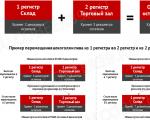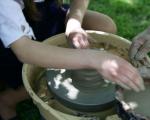Exhibition of art born of fire. Exhibition “Art Born of Fire. Artistic casting of the Urals of the 18th-21st centuries.”
In the halls Sytny Dvor in Kolomenskoye exhibition opened “Art born of fire. Artistic casting of the Urals of the 18th-21st centuries.”, dedicated to the famous artistic casting of cast iron, which, without a doubt, became " business card» The Ural region and Russia as a whole. The traditions of iron casting developed during the reign of Peter I, and in our time this area of Russian decorative and applied art is the most important branch of the domestic art industry.
The uniqueness of the exhibition project lies in the fact that the halls display objects from the collections of twenty museums in our country. These are museums in Moscow, St. Petersburg, Yekaterinburg, Perm, Zlatoust, Chelyabinsk, Yaroslavl. Enterprises from the world-famous Kasli iron foundry center sent their works to the exhibition. Thirteen collectors from different cities and two Moscow antique salons are participating in the project. In total, the exhibition displays more than 1,500 works of decorative and applied art.
The exhibition covers a large historical period of production of cast iron products - the 18th-21st centuries. Art products different eras and the accompanying annotations talk about the improvement of production technologies, demonstrate the huge range and various areas of artistic casting in the Urals, and reveal the beauty of cast iron works.
The exhibits at the exhibition vary in size and purpose. These are busts, medals, vases, candelabra, ashtrays, writing instruments, picture frames, pieces of furniture and household utensils. In addition to mass-produced items, pride of place in the halls is occupied by unique works of iron foundry art with interesting story creation or existence.
Guests are presented with authentic items that were at the first World Exhibition held in Paris in 1900: the sculpture “Russia” by Nikolai Laveretsky; the candelabra that decorated the entrance to the Kasli pavilion (it is interesting that the candelabra were first united in our halls a whole century later, since one of them is permanently kept in the Yekaterinburg Museum, the other in a private collection); keychains that were given to visitors to the World's Fair. In the halls you can see models from which castings were made at factories during the life of Peter I; early cast iron products from the Verkh-Isetsky plant, for example, the “Apotheosis of Alexander” slab, which is an allegory of Russia’s victory over Napoleon. There are also sculptures dedicated to Peace, made for the arrival of US President Ronald Reagan.
The exhibition project consists of three main sections: products from Kasli and Kusa production, as well as products from other factories in the Urals.
The story in the exhibition begins with modern times. Visitors get acquainted with the production facilities that today represent the Russian iron foundry industry in the world and domestic markets. The spiral of time gradually unwinds, and viewers are immersed in the history of Ural artistic casting. The 20th century section presents works reflecting the peaceful labor of Soviet citizens, images of political figures of the USSR and other states, objects with Soviet symbols, themes of war, Soviet sports, ballet, circus, literary series, fairy-tale and cartoon themes, animal art and much more.
The last section includes castings from the Zlatoust, Verkh-Isetsky, Kamensk-Uralsky, Nizhny Tagil, Votkinsk, Verkhne-Ufaleysky, Perm and other Ural plants. The works of different years presented in this section clearly demonstrate that the Ural artistic casting is not one or two separate factories, but an entire industrial branch that has developed over the course of a century.
Two have been prepared for the exhibition printed publications. This is an extensive catalog, with descriptions of more than 1,400 artistic objects made of cast iron and articles about objects that were first introduced into scientific circulation at this exhibition. The second edition is an index of the marks of the Kasli and Kusinsky production, as well as the marks of the Kamensk-Ural plant. The catalog and index are useful reference materials and guides to the exhibition for people interested in artistic casting, and in particular for experts and collectors.
MOSCOW STATE UNITED MUSEUM-RESERVE
KOLOMENSKOYE - IZMAYLOVO - LEFORTOVO - LUBLIN.
Dear ladies and gentlemen, colleagues and friends, lovers of Russian art!
The Kolomenskoye Museum-Reserve invites you to visit a large-scale exhibition project "Art casting of the Urals: XVIII-XXI centuries." The exhibition will be held in the exhibition halls of the Sytny Dvor of the museum-reserve from October 17, 2016 to January 22, 2017.
For the first time, more than a thousand cast iron objects from different eras will be presented in one exhibition space, which will allow the viewer to take a kind of visual excursion into the history of this unique type of Russian artistic production.
The exhibition is designed to awaken interest in the art and collecting of Russian iron castings and to promote patriotic pride in the country and its cultural achievements.
Participants in the exhibition are the oldest state and young private Russian museums, whose funds contain large and diverse collections of the Ural artistic metal, as well as major Russian collectors and Moscow antique galleries, without whose most interesting collections of Kasli and Kusin castings from the 19th - early 21st centuries. the idea of this largest cultural phenomenon of the Russian art industry in Russia cannot be complete and clear.
The art of artistic casting of the Ural factories will be widely represented by the best sculpture, interior, gardening, memorial and architectural castings of the largest iron foundries of the second half of the 19th - early 21st centuries. (Kaslinsky and Kusinsky factories), as well as chamber objects of decorative and applied art of the first half of the 19th century, related to the products of the oldest factories in the Southern Urals (Kushvinsky, Verkh-Isetsky, etc.). Among the exhibits, the exhibition will be presented for the first time in large quantities original bronze models, the presence of which in the production of Ural factories provided them with the breadth and aesthetic diversity of the artistic range of cast iron products. The exhibition will be complemented by rare samples of albums and price lists of artistic castings from the late 19th - first half of the 20th centuries, showing a high professional level of production technology and being best recommendation Ural mining and art industry.
An exhibition catalog is being prepared for publication. We will be glad to see you!
Exhibition administration.
website - preparation for the exhibition.
We are proud to announce that we (“Ural Antiques (website)”) are participants in the first All-Russian exhibition: “Art born of fire. Art casting of the Urals XVIII - XXI centuries.” which will take place this fall in Moscow.
Unique and rare examples of cast iron castings were selected throughout Russia, starting from the best private collections and ending with more than 20 museums. The selection of sculptures was carried out personally by one of the leading experts of the Kolomna Museum - Z. G. Malaeva.
We provided for the exhibition 42 rare exhibits of Kasli casting and we will participate in official opening September 29, 2016 in Kolomenskoye (exhibition halls of the satisfying courtyard), where we will be happy to meet our customers.

"Ural Antiques (site)" is official internet representative All-Russian exhibition “Art born of fire. Artistic casting of the Urals of the 18th-21st centuries.” Moscow.



Photo and video report from the opening of the exhibition.
The All-Russian exhibition "Art Born of Fire. Art Casting of the Urals in the 18th-21st Centuries" began its work. Moscow, Kolomenskoye, exhibition halls of the satisfying courtyard - The most serious large-scale event of the year. I am publishing some photos from the opening of the exhibition.
Opening of the exhibition...

Exhibition exposition...
A brand identification mark for Kasli, Kusa, Kamensk-Uralsk and a catalog for this exhibition have been published.
Assessment by the expert of the branding identifier Kasli, Kusa, Kamensk-Uralsk...
On September 29, 2016 at 16.00 in the halls of the Sytny Dvor of the Moscow State United Museum-Reserve there will be a grand opening of a unique exhibition project dedicated to the famous artistic casting of cast iron, which is the “calling card” of not only the Ural region, but also Russia as a whole.
In the museums of central Russia and in Moscow there is no permanent exhibition on artistic iron casting. The only exhibition dedicated to this phenomenon of domestic industry took place in Moscow more than 75 years ago, back in 1940. Metamorphosis of cast iron, simple and cheap building material, which becomes elegant and aesthetically inspired works of art in the hands of skilled Ural foundry masters, cannot but delight and evoke a feeling of joy and pride in the national culture. The traditions of artistic iron casting began to take shape during the reign of Peter I, and in our time this area of Russian decorative and applied art is the most important branch of the Russian art industry.
The project of the museum-reserve is unique, since the halls display objects from the collections of twenty leading museums of our country, antique salons, private collections, as well as four operating Ural enterprises that today produce artistic casting and covers almost the entire time period of the appearance, development and flourishing of this original art. The exhibition features over 1,500 works of interior and cabinet sculpture, objects of decorative and applied art, memorial, landscape and architectural castings.
The earliest item in the exhibition is from the collection of the State Historical Museum - a floor slab from the tomb of the Gagarin princes, cast in the Urals in 1702. Guests are presented with authentic items that were at the World Exhibition held in Paris in 1900: the sculpture “Russia” by Nikolai Laveretsky; the candelabra that decorated the entrance to the Kasli pavilion (it is interesting that the candelabra were first united in our halls a whole century later, since one of them is permanently kept in the Yekaterinburg Museum, the other in a private collection); keychains that were given to visitors to the World's Fair. In the halls you can see authentic models of E.E. Baumgarten from the collection of the Russian Museum, from which castings were made for the Paris Exhibition; early cast iron products from various Ural factories, for example, the “Apotheosis of Alexander” stove (Verkh-Isetsky factory), which is
an allegory of Russia's victory over Napoleon or a gift from the workers of the Kusye-Alexandrovsky plant to Count Shuvalov - a plate with an image of Mount Grace, where, according to legend, Vogul Stepan Chulpin was burned by his fellow tribesmen for showing ore deposits to the Russian authorities. A unique part of the exhibition is represented by objects from the collections of the State Hermitage and the Russian Museum (St. Petersburg) - early bas-reliefs depicting members of the imperial family, which entered the collection of the State Hermitage from the collection of the famous Russian antiques collector Plyushkin (who served as the prototype for one of the main characters of N. .V. Gogol in “Dead Souls”), original works of art by the famous sculptor K.A. Klodt.
Few people know that the pre-revolutionary Urals could boast of icons made of cast iron, which, unfortunately, have not survived, since they are in Soviet era were sent to the smelter. The more valuable are the remaining copies - posters with images of saints, sculptures. The largest exhibit is “Jesus. (Come to me, all you who suffer)” with a height of 1.3 m and an angel - 1.1 m.
The exhibition presents items presented to royalty and important political figures from different eras. For example, tables cast by the Urals personally for the Secretary General of the USSR L.I. Brezhnev for his famous three books (two of them are presented in the exhibition), genre sculptures dedicated to the theme “World Peace”, made for the visit of US President Ronald Reagan in 1988 . to Moscow.
The modern casting presented at the exhibition is not inferior in quality and beauty to pre-revolutionary ones - before us is the peaceful labor of Soviet citizens, objects with Soviet symbols, themes of Soviet sports, ballet, literary series, fairy-tale and cartoon themes, and much more. Special attention dedicated to a military theme: the Patriotic War of 1812, World War I, Afghanistan and, of course, items dedicated to the Great Patriotic War. These are touching works “Return from the Front”, the defense of Sevastopol, etc. The frozen memory in metal reminds us of the price at which the Great Victory was achieved. Few people know that
Guests will be able to familiarize themselves not only with the exhibits, but also with production technology, literature and sources on the topic of artistic casting. Two printed publications have been specially prepared for the exhibition. This is a catalog and index of hallmarks that are useful reference materials and exhibition guides for people interested in artistic iron casting, and in particular for experts and collectors.
The opening ceremony of the exhibition will be attended by the head of the Moscow Department of Culture A.V. Kibovsky, the Ministers of Culture of the Sverdlovsk (P.V. Krekov) and Chelyabinsk (A.V. Betekhtin) regions, representatives of Mechel PJSC and the Kasli plant, as well as the same administration of the cities of the Urals: Kusa, Kasley, Zlatoust, Yekaterinburg, Perm, Chelyabinsk and directors of participating museums from different cities of our country.
We invite to the halls of the Sytny Dvor all connoisseurs of Russian artistic cast iron casting and those who are not indifferent to the history of decorative and applied arts.
Especially for Peter-T - Lidiya Nikolaeva
On September 29, 2016 at 16.00 in the halls of the Sytny Dvor of the Moscow State United Museum-Reserve there will be a grand opening of a unique exhibition project dedicated to the famous artistic casting of cast iron, which is the “calling card” of not only the Ural region, but also Russia as a whole.
In the museums of central Russia and in Moscow there is no permanent exhibition on artistic iron casting. The only exhibition dedicated to this phenomenon of domestic industry took place in Moscow more than 75 years ago, back in 1940. The metamorphosis of cast iron, a simple and cheap building material, which becomes elegant and aesthetically inspired works of art in the hands of skilled Ural foundry masters, cannot but delight and evoke a feeling of joy and pride in the national culture. The traditions of artistic iron casting began to take shape during the reign of Peter I, and in our time this area of Russian decorative and applied art is the most important branch of the Russian art industry.
The project of the museum-reserve is unique, since the halls display objects from the collections of twenty leading museums of our country, antique salons, private collections, as well as four operating Ural enterprises that today produce artistic casting and covers almost the entire time period of the appearance, development and flourishing of this original art. The exhibition features over 1,500 works of interior and cabinet sculpture, objects of decorative and applied art, memorial, landscape and architectural castings.
The earliest item in the exhibition is from the collection of the State Historical Museum - a floor slab from the tomb of the Gagarin princes, cast in the Urals in 1702. Guests are presented with authentic items that were at the World Exhibition held in Paris in 1900: the sculpture “Russia” by Nikolai Laveretsky; the candelabra that decorated the entrance to the Kasli pavilion (it is interesting that the candelabra were first united in our halls a whole century later, since one of them is permanently kept in the Yekaterinburg Museum, the other in a private collection); keychains that were given to visitors to the World's Fair. In the halls you can see authentic models of E.E. Baumgarten from the collection of the Russian Museum, from which castings were made for the Paris Exhibition; early cast iron products from various Ural factories, for example, the stove "Apotheosis of Alexander" (Verkh-Isetsky plant), which is an allegory of Russia's victory over Napoleon, or a gift from the workers of the Kusye-Alexandrovsky plant to Count Shuvalov - a dish with an image of Mount Grace, where, according to legend, Vogul was burned Stepan Chulpin by his fellow tribesmen for showing ore deposits to the Russian authorities. A unique part of the exhibition is represented by objects from the collections of the State Hermitage and the Russian Museum (St. Petersburg) - early bas-reliefs depicting members of the imperial family, which entered the collection of the State Hermitage from the collection of the famous Russian antiques collector Plyushkin (who served as the prototype for one of the main characters of N. .V. Gogol in “Dead Souls”), original works of art by the famous sculptor K.A. Klodt.
Few people know that the pre-revolutionary Urals could boast of icons made of cast iron, which, unfortunately, were not preserved, since they were melted down in Soviet times. The more valuable are the remaining copies - posters with images of saints, sculptures. The largest exhibit is “Jesus. (Come to me, all you who suffer)” with a height of 1.3 m and an angel - 1.1 m.
The exhibition presents items presented to royalty and important political figures from different eras. For example, tables cast by the Urals personally for the Secretary General of the USSR L.I. Brezhnev for his famous three books (two of them are presented in the exhibition), genre sculptures dedicated to the theme “World Peace”, made for the visit of US President Ronald Reagan in 1988 . to Moscow.
The modern casting presented in the exhibition is not inferior in quality and beauty to pre-revolutionary ones - before us is the peaceful labor of Soviet citizens, objects with Soviet symbols, themes of Soviet sports, ballet, literary series, fairy tale and cartoon themes, and much more. Particular attention is devoted to the military theme: the Patriotic War of 1812, World War I, Afghanistan and, of course, items dedicated to the Great Patriotic War. These are touching works “Return from the Front”, the defense of Sevastopol, etc. The frozen memory in metal reminds us of the price at which the Great Victory was achieved.
Guests will be able to familiarize themselves not only with the exhibits, but also with production technology, literature and sources on the topic of artistic casting. Two printed publications have been specially prepared for the exhibition. This is a catalog and index of hallmarks that are useful reference materials and exhibition guides for people interested in artistic iron casting, and in particular for experts and collectors.
We invite to the halls of the Sytny Dvor all connoisseurs of Russian artistic cast iron casting and those who are not indifferent to the history of decorative and applied arts.
Directions: metro station "Kolomenskaya"
Entrance from the Kolomenskaya metro station














